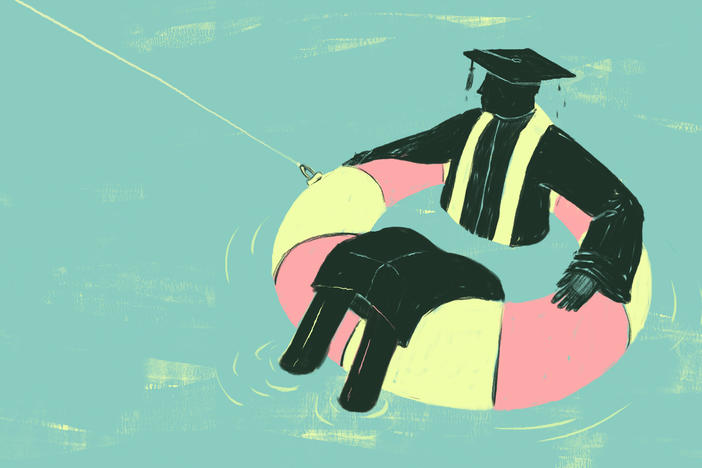Section Branding
Header Content
Borrowers can now apply for new, income-based student loan repayment
Primary Content
A new repayment program opens today to more than 20 million student loan borrowers, with payments based on their income and family size.
The Biden administration announced the Saving on a Valuable Education (SAVE) program earlier this summer, following the Supreme Court's decision to overturn their proposed loan cancellation program.
"We refuse to go back to those days before the pandemic when nearly a million borrowers defaulted on their loans every single year because they couldn't afford the payments," Education Secretary Miguel Cardona said on a press call. "Starting today, borrowers can enroll in the most affordable student loan repayment plan ever available."
The SAVE program does not deliver debt forgiveness in one fell swoop, as the administration initially sought to do. But millions of borrowers – including those with higher incomes – will see some of their debt forgiven under this plan.
The program will calculate monthly payments based on the borrower's income and family size. The administration estimates that under SAVE more than a million borrowers will qualify for $0 monthly payments, while the average borrower will save about $1,000 a year. The new plan also seeks to prevent interest from exploding.
"The nightmare of making payments and watching your loan balance get bigger and bigger will finally be over," Cardona says.
Under the SAVE plan, as long as borrowers make their monthly payments, interest will not accumulate. With previous plans, borrowers with low or $0 payments — too low to cover their monthly interest charge — saw that interest accrue. Now, the government says, that won't happen.
The department says that under the old plan, borrowers repaid, on average, $10,956 for every $10,000 they borrowed. Under the new plan, they would pay back just $6,121.
"This is a big new loan forgiveness policy, particularly for undergraduates," says Jason Delisle, who studies higher education at the Urban Institute.
In a January review of the SAVE plan, Delisle and his colleagues found that, for bachelor's degree recipients, "the share fully paying off their loans would fall from 59 percent under current [income-driven repayment] to 22 percent."
Who qualifies?
Borrowers with federally held loans including direct subsidized, unsubsidized and consolidated loans qualify for SAVE.
Those with Federal Family Education Loans (FFEL) or Perkins Loans that are held by a commercial lender would need to consolidate that debt into a federal direct loan in order to qualify.
Parents who took out a federal loan to help their children pay for college (known as Parent PLUS loans) are not eligible for SAVE, but are eligible for other income-driven repayment plans. Borrowers can find the best plan for them at studentaid.gov
Unlike the now defunct forgiveness program, the SAVE program will benefit not only current student loan borrowers, but also future ones.
How can I apply?
Borrowers can now apply at studentaid.gov/SAVE . In an announcement video, President Biden assured borrowers that the application will take "10 minutes."
The program allows borrowers to opt in to a feature that allows the Education Department to access their tax returns from the Internal Revenue Service. This will allow the department to automatically recertify borrowers' enrollment every year, so they don't have to keep applying and updating.
The administration is urging borrowers to apply soon because, after three years of pause extensions, student loan payments are set to resume in October, with interest starting to accrue in September.
A senior administration official told reporters that borrowers who apply early enough will be able to see the new plan's savings reflected in their first payment in October.
Copyright 2023 NPR. To see more, visit https://www.npr.org.
Bottom Content




